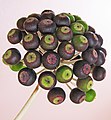Fatsia japonica
| Fatsia japonica | |
|---|---|

| |
| Scientific classification | |
| Kingdom: | |
| (unranked): | |
| (unranked): | |
| (unranked): | |
| Order: | |
| Family: | |
| Genus: | |
| Species: | F. japonica
|
| Binomial name | |
| Fatsia japonica | |
Fatsia japonica (Fatsi or Japanese Aralia; syn. Aralia japonica Thunb., A. sieboldii Hort. ex K.Koch) is a species of Fatsia, native to southern Japan and South Korea.
It is an evergreen shrub growing to 3–6 m (9.8–19.7 ft) tall, with stout, sparsely branched stems. The leaves are spirally-arranged, large, 20–50 cm (7.9–19.7 in) in width and on a petiole up to 50 cm (20 in) long, leathery, palmately lobed, with 7–9 broad lobes, divided to half or two-thirds of the way to the base of the leaf; the lobes are edged with coarse, blunt teeth. The flowers are small, white, borne in dense terminal compound umbels in late autumn or early winter, followed by small black fruit.
The name "Fatsi" is an approximation of the old Japanese word for 'eight' (hachi in modern Japanese), referring to the eight lobes. In Japan it is known as Yatsude meaning eight fingers. The name "Japanese Aralia" is due to the genus formerly being classified within a broader interpretation of the related genus Aralia in the past. It has been interbred with Hedera helix (common ivy) to produce Fatshedera lizei.
This plant,[1] together with its cultivar F. japonica variegata,[2] has gained the Royal Horticultural Society's Award of Garden Merit.
Cultivation and uses
It is commonly grown as an ornamental plant in warm temperate regions where winters do not fall below about -15°C. F. japonica have been shown to effectively remove gaseous formaldehyde from indoor air.[1]
Naturalisation
While grown as a landscaping plant, it has also become naturalised in some areas. In New Zealand it has become established in waste areas and abandoned gardens.
Health
The sap, which is sticky and resinous, can cause contact dermatitis in sensitive people.
-
Fruiting body
-
A small Fatsia japonica leaf
-
Close-up of flower umbel
References
- ^ "Efficiency of Volatile Formaldehyde Removal by Indoor Plants: Contribution of Aerial Plant Parts versus the Root Zone". Journal of The American Society for Horticultural Science. 133 (4): 521–526. July 2008. ISSN 0003-1062.
{{cite journal}}: Unknown parameter|authors=ignored (help)
Further reading
- Huxley, A., ed. (1992). New RHS Dictionary of Gardening. Macmillan.
- BBC Gardening: Fatsia japonica
- Poplay, I. et al. (2010). "An illustrated Guide to Common Weeds Of New Zealand" 3rd ed. Pg. 36



